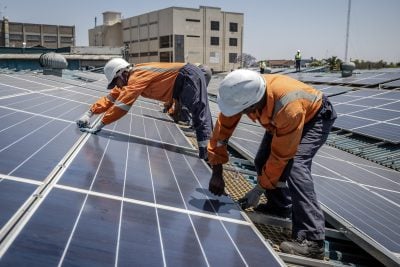Geothermal energy, harnessed from the immense heat of the Earth’s core, has helped Kenya to make dramatic progress in extending access to electricity in recent years. Geothermal power plants now produce around half of the country’s electricity. And, with much greater potential still to be developed, a host of industries are looking to set up shop in Kenya to make use of these abundant and renewable energy resources in their facilities.
But geothermal energy can be used for more than generating electricity. Rather than using steam produced from the superheated water deep beneath the Earth’s surface to drive turbines that produce electricity, it is equally possible to make use of the heat directly. Many countries have already learned to harness geothermal heat in their agribusiness sectors.
Geothermal energy can be used, for example, to heat and cool greenhouses. Iceland, on the edge of the Arctic Circle, is able to grow many types of fruits and vegetables locally because of its geothermally-heated greenhouses. Geothermal heat can also be used for sterilising soils, drying crops and pasteurising milk. And it is widely used in aquaculture, to heat pools to the optimum temperatures for different types of fish.
So far, Africa has barely scratched the surface of geothermal energy in the agribusiness sector. A handful of projects, almost exclusively in Kenya, are supplying geothermal power in greenhouses and other agricultural enterprises. Far greater potential is still to be tapped both in Kenya and many other countries.
Growing with geothermal
While understanding around geothermal energy is greater in the Global North, Africa is now beginning to “realise the potential opportunities around geothermal heating and cooling,” says Helen Robinson, regional manager for Africa at the International Geothermal Association. Geothermal power can make an important contribution to addressing food security challenges, she adds.
To generate electricity, access to geothermal wells that contain water or steam heated to at least 150 degrees Celsius is usually needed. However, water at much lower temperatures can still be used to provide heating for “direct use” projects – including in agriculture.
As an example, Robinson cites a pilot project at the Menengai site in Kenya’s Nakuru County. Here, the country’s Geothermal Development Company (GDC), in collaboration with the US Agency for International Development, has been trialling the direct use of geothermal in several agriculture and aquaculture applications since 2015.
The GDC developed a “cascade system”, whereby slowly-cooling water is used in multiple applications. “You’ve got a top-end temperature,” says Robinson, “and a top-end application. And as it cascades down through the different applications, it loses some temperature, but there’s still temperature there that they can apply to something else.” At Menengai, the hottest water – around 87 degrees – is used in a milk pasteurisation facility; as the water loses heat, it is then used for grain drying, fish farming and finally to warm greenhouses.
The need for heating in greenhouses may not be as obvious in Africa compared to an environment like Iceland. However, the ability to control temperatures throughout the day and night can still be vital to producing optimum growing conditions.
Maintaining a stable temperature reduces condensation, which then helps lower the risk of fungal infections. Geothermal systems are also used for cooling purposes in greenhouses, with excessively warm air pumped underground to release heat.
Elsewhere in Kenya, adjacent to the mighty Oserian Development Company geothermal fields where several power stations are clustered, the Oserian Development Company began using geothermal heat in its greenhouses in the early 2000s. Several more small-scale geothermal facilities have been brought online at the site, which mainly produces roses and other cut flowers for export.
This is, however, one of the only truly large-scale examples of geothermal energy being used in a major agribusiness enterprise in the whole of Africa.
Geothermal race heats up
Kenya, which straddles the East African Rift Valley – a fault line along which the African continent is being ripped apart – is far ahead of any other African country in developing its geothermal resources. Ethiopia also has excellent potential, but has been slower to ensure that commercial conditions are in place for its resources to be developed. Electricity production from geothermal sources is mostly confined to areas of the world where tectonic activity is most intense. But the fact that direct-use projects for heating and cooling require much lower temperatures means that many more countries could be in a position to make use of geothermal power in agriculture.
Zambia is one country that could benefit. Developer Kalahari GeoEnergy is set to commission a small pilot plant later this year, with a goal of scaling up to 12 MW capacity by 2030.
Its pilot plant will initially be used to produce energy for a dairy processing plant. Peter Vivian-Neal, Kalahari GeoEnergy’s CEO, said in June that it would focus on producing energy for agri-industrial processes alongside electricity for the wider market in order to improve food security.
Robinson says that the project is being closely watched by stakeholders from other African countries, including Namibia, Botswana, South Africa, Malawi and Tanzania. These countries also have an interest in developing lower-temperature geothermal resources for use in the agribusiness sector.
“I think once that’s up and running, that is going to be that demonstrable example of power, heating and cooling opportunities away from East Africa,” says Robinson.
No guarantee of steam
Nevertheless, while the potential benefits for agriculture and other industries is clear, drilling wells and developing geothermal facilities is far from straightforward.
The development phase can be a costly and relatively high-risk process. Much like with prospecting for oil, there is no way to be sure that a well contains a commercially viable resource until it is drilled.
The International Renewable Energy Agency noted in a 2020 report that “several projects in the region are stuck at the exploration stage” owing to challenges in raising finance, a lack of understanding of geological conditions and inadequate policy and regulatory regimes. It also warned that there is limited understanding of the direct use potential of geothermal energy in Africa.
Robinson says that these challenges persist. The biggest challenge, she says, is financing. Investors are cautious due to the risk of failure, although improved drilling technology is helping to reduce the costs of exploration.
She also points out that developers need to be flexible in order to succeed in the geothermal industry. While most developers would prefer to discover high-temperature resources that can supply electricity to national electricity grids, the reality is that many wells turn out to offer access to lower temperatures.
Robinson notes that the well at Menengai, where the GDC has its direct use pilot project, had been drilled in the hope that it would be able to generate electricity – but, with temperatures of around 100 degrees Celsius, this proved unviable.
Flexibility from developers, alongside greater awareness of the benefits among policymakers, certainly offers the prospects of geothermal energy playing a greater role in African agriculture. The impact on food production could be transformative.
Want to continue reading? Subscribe today.
You've read all your free articles for this month! Subscribe now to enjoy full access to our content.
Digital Monthly
£8.00 / month
Receive full unlimited access to our articles, opinions, podcasts and more.
Digital Yearly
£70.00 / year
Our best value offer - save £26 and gain access to all of our digital content for an entire year!

 Sign in with Google
Sign in with Google 



